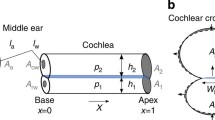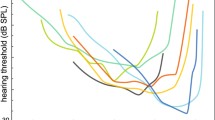Abstract
In this paper the cochlea of the ear is considered as a transmission line. Calculations have been carried out on a line whose capacity varies in an exponential way with distance and which has negligible losses. These have shown that a sinusoidal excitation does not propagate beyond a certain point in the line. It is also shown in the paper that it is legitimate to consider the cochlea as a line of this type.
Sommaire
Dans cet article on considère le limaçon de l'oreille comme une ligne de transmission. Des calculs ont été effectués sur une ligne dans laquelle la capacité varie de façon exponentielle avec la distance et de pertes négligeables. Ceci a montré qu'une excitation sinusoidale ne se propageait que jusqu'en un certain point d'une telle ligne. On y démontre aussi qu'il est légitime de considérer le limaçon comme une ligne de ce type.
Zusammenfassung
In dieser Arbeit wird die Cochlea des Hörorgans als eine Transmissionslinie betrachtet. Auf einer Linie, deren Kapazität exponentiell mit der Entfernung abnimmt, und deren Dekremente signifikant sind, wurden Berechnungen durchgeführt. Sie zeigen, daß eine sinusförmige Erregung nur bis zu einem bestimmten Punkt auf der Linie läuft. Die Berechtigung der Betrachtung der Cochlea als eine derartige Linie wird nachgewiesen.
Similar content being viewed by others
References
Bekesy, G. v. (a) (1941) Über die Elastizitat der Schneckentrennwand des Ohres,Akust. Z.,6, 265–278; (b) (1948) On the elasticity of the cochlear partition,J. acoust. Soc. Am.,20 227–241 (23–25, 469–480).
Bekesy, G. v. (a) (1942) Über die Schwingungen der Schneckentrennwand beim Präparat und Ohrenmodell,Akust. Z.,7, 173–186; (b) (1949) The vibration of the cochlear partition in anatomical preparations and in models of the inner ear,J. acoust. Soc. Am.,21, 233–245 (30, 429–446).
Bekesy, G. v. (a) (1943) Über die Resonanzkurve und die Abklingzeit der verschiedenen Stellen der Schneckentrennwand,Akust. Z.,8, 66–76; (b) (1949) On the resonance curve and the decay period at various points on the cochlear partition,J. acoust. Soc. Am.,21, 245–254 (446–460).
Helmholtz, H. L. F. (1863)Die Lehre von den Tonempfindungen als physiologische Grundlage für die Theorie der Musik, (1st Edn.), Brunswick, Germany, Viewegverlag (English trans. byA. J. Ellis, (1885)On the sensations of tone), (2nd English Edn.).
Hurst, C. H. (1895) A new theory of hearing,Proc. Trans. Lpool biol. Soc.,9, 321–353.
Kuile, E. ter. (a) (1900) Die Übertragung der Energie von der Grundmembran auf die Haarzellen,Pflügers Arch. ges. Physiol.,79, 146–157; (b) (1900) Die richtige Bewegungsform der Membrana basilaris,Pflügers Arch. ges. Physiol.,79, 484–509.
Lampard, D. G. Monash University, Australia. Private Communication.
Ranke, Otto F. (a) (1950) Theory of operation of the cochlea: Contribution to the hydrodynamics of the cochlea,J. acoust. Soc. Am.,22, 772–777; (b) (1950) Hydrodynamik der Schneckenflussigkeit,Z. Biol.,103, 409.
Watt, Henry J. (1914) Psychological analysis and theory of hearing.Br. J. Psychol.,7, 1–43.
Yoshii, U. (1909)Z. Ohrenheilk.,58, 201;Wittmaach (1907)Z. Ohrenheilk.,54;Marx (1909)Z. Ohrenheilk.,59;Pavlov I. (1927)Conditional Reflexes. Oxford University Press.
Zwislocki, J. (a) (1948) Theorie der Schneckenmechanik, Acta Oto-laryngol. Suppl. 72; (b) (1950) Theory of the acoustical action of the cochlea,J. acoust. Soc. Am.,22, 778.
Author information
Authors and Affiliations
Additional information
Based on a paper read at the 6th International Conference on Medical Electronics and Biological Engineering, Tokyo, August 1965.
Rights and permissions
About this article
Cite this article
Guelke, R. An explanation of the travelling wave theory of hearing. Med. & biol. Engng. 4, 349–356 (1966). https://doi.org/10.1007/BF02476152
Issue Date:
DOI: https://doi.org/10.1007/BF02476152




